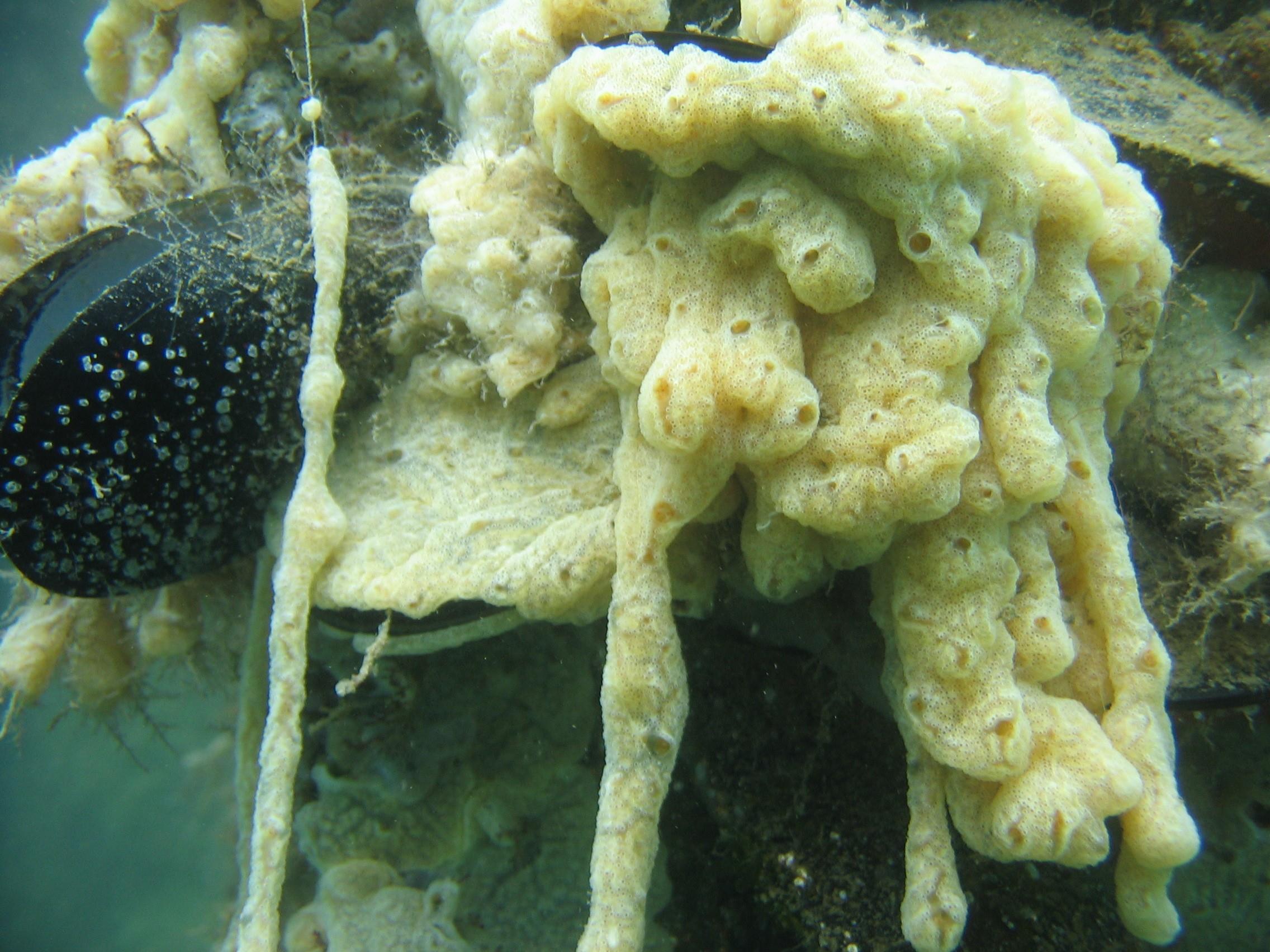Didemnum vexillum
Colonial Tunicate / Sea Squirt
Synonym(s): Didemnum sp. A.
Class: Ascidiacea
Order: Aplousobranchia
Family: Didemnidae

Photographer: Paul Barter
Source: http://woodshole.er.usgs.gov/project-pages/stellwagen/
Description
Didemnid colonies take various forms. Where the current is weak, they hang from hard structures in long stringy lobes resembling ropes. Where the current is strong, they grow in dense flat mats. Like other tunicates, the colonies are formed of individuals called zooids. Colonies are tan, cream-colored, white or yellow and can grow up to a diameter of 5 ft.
Ecological Threat: This tunicate is more of a threat then the colonial tunicate (Botrylloides violaceus) because it is an aggressive invader and a threat to a marine life including commercial shellfish fisheries. Studies have shown the tunicates directly affecting the Atlantic Cod and haddock by reducing the habitat available to deposit their eggs. It has no natural predators in our area, since it creates metabolic toxins, and grows rapidly in size it is able to take over and smother out other native species. It has also invaded other areas, including the East Coast, New Zealand, and the Prince Edward Islands, where it's a huge problem.
Biology: Didemnum vexillum a filter feeder that eats zooplankton, phytoplankton, and detritus. It is hermaphroditic and breeds sexually by broadcast spawning and asexually by budding. Breeding occurs when water temperatures are higher, usually early spring and fall. Didemnum vexillum does not grow in the winter, and in fact dies back a bit during that time period. A new colony can form from fragmentation when a lobe of the colony breaks off and drifts to different location. Such stray pieces may attach to a new substrate within six hours of arrival and start overgrowing it.
History: Introductions likely due to shipping (either via hull or sea chest fouling). It was first officially documented in Maine in 1993, but there are suggestions that it has been in New England waters since the 1970s. In the same year (1993) it was found in San Francisco Bay California and five years later in 1998 it was found in Monterey Bay California. It was first documented off the Washington state coast at Puget Sound in 2004 and was confirmed off of the coast of Oregon in 2010.
U.S. Habitat: Sub-tidal zone, attached to rocks, boulders, and artificial structures such as pilings and floating docks. It can also be found growing over seaweeds, sponges, shellfish, and other tunicates but can also be found growing in depths up to 65 meters.
Distribution
Native Origin: Japan
U.S. Present: CA, ME, MD, MA, NH, OR, RI, VT, WA
Management
Didemnum vexillum can be removed from an infested object by scraping them off and placing them in the garbage or letting them dry out. When pressure washing colonial tunicates off equipment, only do so on land and make sure the resulting waste-water does not go back into the sea, as these tunicates can often re-grow from small fragments. With acetic acid and bleach treatments, D. vexillum can be removed from shellfish. Wrapping affected areas in plastic has also been tried as a control method, with some success
Text References
Woodward, Susan L., and Joyce Ann. Quinn. 2011. Colonial Tunicate. Encyclopedia of Invasive Species: From Africanized Honey Bees to Zebra Mussels. Santa Barbara, CA: Greenwood. 42-44. Print.
Internet Sources
http://www.invasivespeciesinfo.gov/aquatics/seasquirt.shtml
http://www.pnwscuba.com/invasives/didemnum.htm
http://woodshole.er.usgs.gov/project-pages/stellwagen/didemnum/
https://sites.google.com/a/rsu5.org/invasive/maine-invasive-species/sea-squirt-didemnum-vexillum
 Texas Invasive Species Institute
Texas Invasive Species Institute